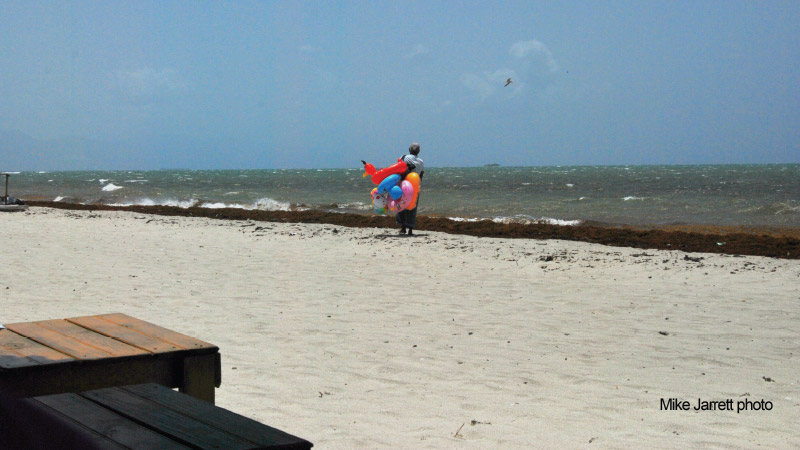By Mike Jarrett
The sun was high and there was barely a cloud in the sky. However, vendors who depended on the brisk weekend trade on the beaches on the south and west of Kingston, Jamaica found only deserted stretches of white sand in the first week of July.
The bustle of activity normally expected on the beaches of Hellshire on a scorching Saturday afternoon was nowhere to be found. There was no beach volleyball, no children chasing each other, no vendors selling everything from oysters to wood carvings. Instead, there was an eerie quietness, disturbed only by an occasional gust from the south, ripping through the sea grape branches.
The answer to the obvious question was not far away. It lined the beach as far as the eyes could see and coloured the coastal waters brown. What was left on the beach-head during high tide was now rotting ... stink from the decomposing cells of dead flora and fauna. The air was abuzz with flies.
The lone vendor walked the long deserted beach in futility, kicking occasionally in disgust at a knot of the offensive sargassum that blew across his path.
His brightly coloured floatable toys would find no eager hands on this day. But he walked the lonely way, only because sitting and staring into the water was the only alternative. He wondered, like so many across the Caribbean region who depend on the beach for a livelihood, when the brown curse would disappear.
The first huge rafts of sargassum involved in the current phenomenon reportedly washed up on Eastern Caribbean shores in 2011. Professor Hazel Oxenford of the University of the West Indies (Cave Hill) told BBC that it came as a surprise and no one knew what to do with it. In the years following, the sargassum continued to flow into the Caribbean in larger quantities. In a matter of three years Caribbean governments knew they had a problem that posed a serious threat to national economies and, in particular, the tourism and fishing subsectors.
Reports of business closures and loss of business multiplied. Horror stories of danger to the environment and about rafts of sargassum entangling and decimating whole bales of foraging sea turtles caused grave concern to environmentalists. Plus, reports about huge sums spent, to no avail, on heavy machinery to clean up private beaches have given real cause for dismay.
ANSWERS
There are apparently no quick fixes to the problem. It could well get worse before it gets better. However, a lot of studies and observations have been done (or are continuing) and progress is being made. Tourism ministries, port and harbour authorities and port and shoreline protection agencies must keep abreast of the latest information and technology for dealing with sargassum.
It is against this background that the study of the sargassum invasion and the current best practices for coping with it will proceed at the 2019 Caribbean Port Management Workshop, scheduled for January 21, 22 and 23 in Kingston, Jamaica.
AN APP TO MONITOR
At the upcoming second annual Caribbean Port Management Workshop, the DHI group plans to launch a software application (app) which will facilitate the process of building a regional network for monitoring and collecting data. This ready exchange of real-time information will empower port authorities and others to monitor sargassum movement and prepare themselves for an ‘invasion’.
“The app we intend to launch will not save anyone from seaweed. The main idea is to provide the ports of the Caribbean region with a tool to register seaweed movement and record information on the wind and currents that brought the seaweed to land. They will also be able to upload photographs. When the user has registered an occurrence, it will be visible on a map in the app and other port authorities (or holiday resorts) can see where the seaweed is and seize the opportunity to prepare themselves for an ‘attack’ from seaweed,” said Jesper Dannisøe of the DHI Group, Moderator of Track 1 of the Caribbean Port Management Workshop.
He further explained: “The app was not developed for seaweed but for recording of droughts and flooding events. But it has an option called ‘Pollution’, which can be used. I will of cause provide a user-guide for how to use it and it will be free of charge. Potentially, it could also be used for real-time monitoring of hurricane incidents.”
The Caribbean Port Management Workshop is presented by PORTSIDE CARIBBEAN in collaboration with the Port Management Association of the Caribbean and the Caribbean Maritime University.

